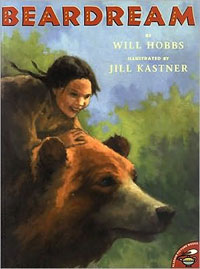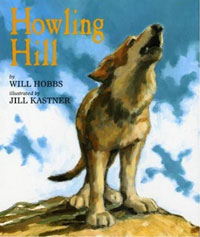 |
For years teachers and librarians had been asking me to write something for the younger kids. When my editor, independently, suggested the same thing, I decided to give it a try. Where did you get the idea for the story? Earlier, when I was researching my novels Bearstone and Beardance, I'd come across the idea that the Ute people, in ancient times, had learned the beardance from the bears. This ceremonial dance is still very much alive today among the modern Ute people. It sounded like the perfect idea for a picture book, plus it would make a nice companion to my novels. For this story, my main character could be much younger, to match the age of the audience. The little boy in the story is named Short Tail. How did you come up with that name? Short Tail is one of the many names given to bears in ancient times, so I thought it would work well to give my character a “bear” name, since he feels a special connection to the bears. You'll notice that he calls the old, over-hibernating bear “Grandfather,” and also, “Old Honey Paws.” These too are ancient names for bears, found in many native traditions. I have an Author's Note at the end of this book that tells more about the writing of this story. How did you get hooked up with your illustrator, Jill Kastner? My editor showed me books by a number of illustrators, and I thought Jill would be perfect for my story. Not only did Jill agree to do the book, she called and told me that she and her husband would like to come out from New Jersey to Colorado to research the locations and the cultural background for the story. I was thrilled! We would be able to meet, and to put our heads together about our project. I'll bet you learned a lot about how an illustrator works I sure did. One thing I learned is that they take lots and lots of pictures. We went hiking together in the mountains, and Jill photographed everything from mountain peaks and spruce trees to rocks, caves and tangled branches. Beardream ended up looking so authentic because she took well over a hundred color photographs and used them as the basis for her oil paintings. She was also able to arrange a photo shoot with a young Ute boy from Cortez, Colorado, who would be the model for Short Tail. She went home with several excellent books about the Utes, and did a terrific job of bringing the story to life through her art. Then came the wolf story that the two of you did together, Howling Hill. Tell us about that one. We both knew we'd like to work together again. I sounded her out about the idea of illustrating a wolf story. “I love wolves,” she said, “and so do kids! I've always wanted to draw wolves.” The only trouble was, I hadn't written the story yet. My wife and I were about to take off on a six-week driving trip that would take us all the way to the Arctic Ocean. No problem, I thought, I'll write it on the picnic tables in the campgrounds. Well, I tried. I couldn't write a wolf story on my yellow notepad to save my life. What was the problem? Looking back, I think there were two problems. First, I was trying to write longhand. For years I had been writing on a word processor. Second, I didn't have a specific setting in mind. A specific landscape has always been so important in my books, and always gives me story ideas. As soon as I got back home, I jumped on my keyboard, and decided to give the wolf story the same setting as my novel, Far North—the amazing Nahanni River, with its 385-foot waterfall, Virginia Falls. Bingo! I wrote the first draft of the story in a couple days, after I'd been tearing my hair out for months. Can you give a couple of examples of landscape features along the river that suggested story ideas? From our river trip on the Nahanni, I remembered a huge tufa mound alongside the river with hot springs and brightly colored mineral formations. I imagined that the top of this mound could be the favorite howling place of a wolf family. The little wolf in the story could be named Hanni, after the great Nahanni River, and she's having trouble learning to howl. Then she gets separated from her family and finds herself floating down the river, heading for the waterfall. . . . She gets help in the story from a bear that can't hibernate. That's right, and this one has insomnia. His problem is exactly the opposite of the oversleeping bear in Beardream. Did you meet up with Jill Kastner while you were working on the second book together? No, but she asked me to send her my photos from the Nahanni River so that her illustrations would be true to the setting. Also she encouraged me to send her lots of stuff on wolves. We were in good touch. When Howling Hill came out, Jean and I invited Jill and Tim to join us on a San Juan River trip in southeast Utah. It was a great way to celebrate the two books we had done together. Do you think you'll write more picture books? I'd love to. Young children are a wonderful audience. I once had the chance to read Howling Hill to a whole auditorium full of first and second graders. When I got to the part at the end when Hanni finally howls, all those kids started howling, spontaneously. I got major goosebumps. Do the readers of your novels read your picture books? They do quite a lot. A good picture book works for people of all ages, and older kids are especially interested in Beardream and Howling Hill because they tie in to my novels. Beardream is a companion to Bearstone and Beardance while Howling Hill is a companion to Far North. |
|

